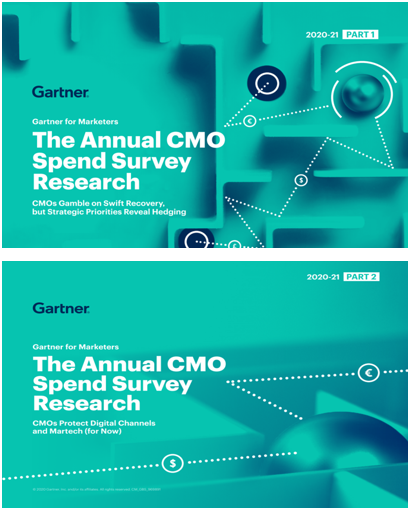Gartner’s annual report on the allocation of marketing budgets was recently published. Its natural background in 2020 is the pandemic crisis. The report shows that marketing directors are rather optimistic about recovering from the COVID-19 crisis, with 57% expecting their business to recover within 18-24 months. This is despite the fact that 44% expect crisis-related cuts in their budgets.
It is worth considering what conclusions and guidelines result from detailed questions asked by Gartner to 432 marketing directors of large companies from the US, UK, Germany and France.
1. Consider the risk approach carefully
Against the background of the current economic and social situation, it is not surprising that marketing directors have a rather conservative and risk-averse approach. As much as 79% intend to achieve growth in existing markets either by creating new products (45%) or by focusing on existing products (34%). At the same time, 69% of CMOs declare explicitly that they intend to focus either on maintaining the status quo (37%) or taking very limited risks (32%). Only 25% are ready to spend part of their budgets and resources on experimenting with new marketing methods and strategies. An interesting aspect is the acceptance of risk taking from the broader enterprise. The distribution of responses for maintaining the status quo and taking very limited risks is 20% and 43% respectively. This means that local marketers’ preferences for taking risks are actually more conservative than the strategies of global headquarters.
Against this background, each CMO should carefully consider how far relatively conservative actions will actually generate business growth. The large market changes we face often reward companies that are more bold in their actions than their categories. Attempting to operate in new markets, reaching out to new consumer groups, innovative product R&D or innovation in the channels of reaching customers or distribution are activities that, while requiring investment and an experimental approach, can effectively create an advantage for post-crisis times. Incidentally, they can also effectively build the careers of CMOs that decide to do so.
2. Continually shift your priorities and metrics towards business
In times of crisis, marketers consider brand strategy as their top priority. This is undoubtedly an appreciation of the solid foundations on which profitable brands, capable of surviving and developing during the crisis, must be based. At the same time, “digital commerce” is considered to be the fourth key tactic for increasing growth in the concentration on current markets. As a side note, one of the most popular reactions to the crisis was to increase the promotion of e-commerce offers (40%). This shows the growing importance of areas directly related to business generation. The declarations of CMOs as to the most valuable measures in their work say even more about this scope. ROI comes first (19%), followed by generating qualified marketing leads (18%) and sales leads (15%) and conversions (14%). Interestingly, the CSAT (i.e. customer satisfaction level), which, according to numerous studies, strongly correlates with business results of companies, is also in the group of the most valuable measures. Another group of measures includes market share or customer acquisition cost (CAC).
This only confirms the tendency, which has been visible for many years, that a modern CMO must firstly focus its efforts on the areas which have a real impact on business growth and be able to prove this impact in the best possible way by using appropriate measures of their work.

3. Carefully think about your investment in technology
Marketing directors’ expenditure on martech technologies remains high at 26.2%. At the same time, 68% of CMOs declare that they will increase the in the coming years. What could be the reason for this trend? Firstly, the transfer of some of the previously outsourced marketing services into the organization. Marketing directors in Gartner’s survey declare an average of 32% of services transferred from various types of agencies to their own structures. This entails the need to build the highest possible efficiency, with unrelenting pressure on personnel costs, in marketing departments. This, in turn, naturally directs attention towards a properly configured set of marketing technologies (martech stack). At the same time, in the group of activities most often transferred are those that are strongly supported by technological tools, such as social media (53%) or programmatic (38%). On top of all this, companies should focus more and more on in-depth analyses or the already mentioned e-commerce area.
In the context of technology, the decline of marketing personalization on the list of priorities is extremely interesting, but as Gartner analysts claim, this trend is understandable. The evolution of marketing practices towards data-driven personalization is a long and complex process and many companies are disappointed by the lack of quick returns in this area. Based on this, Granet estimates that by 2025, as many as 80% of companies that have undertaken marketing personalization efforts will abandon them. This does not diminish the effectiveness of this marketing practice, however, it indicates its difficulty and the need to understand the long-term nature of the effects achieved.

